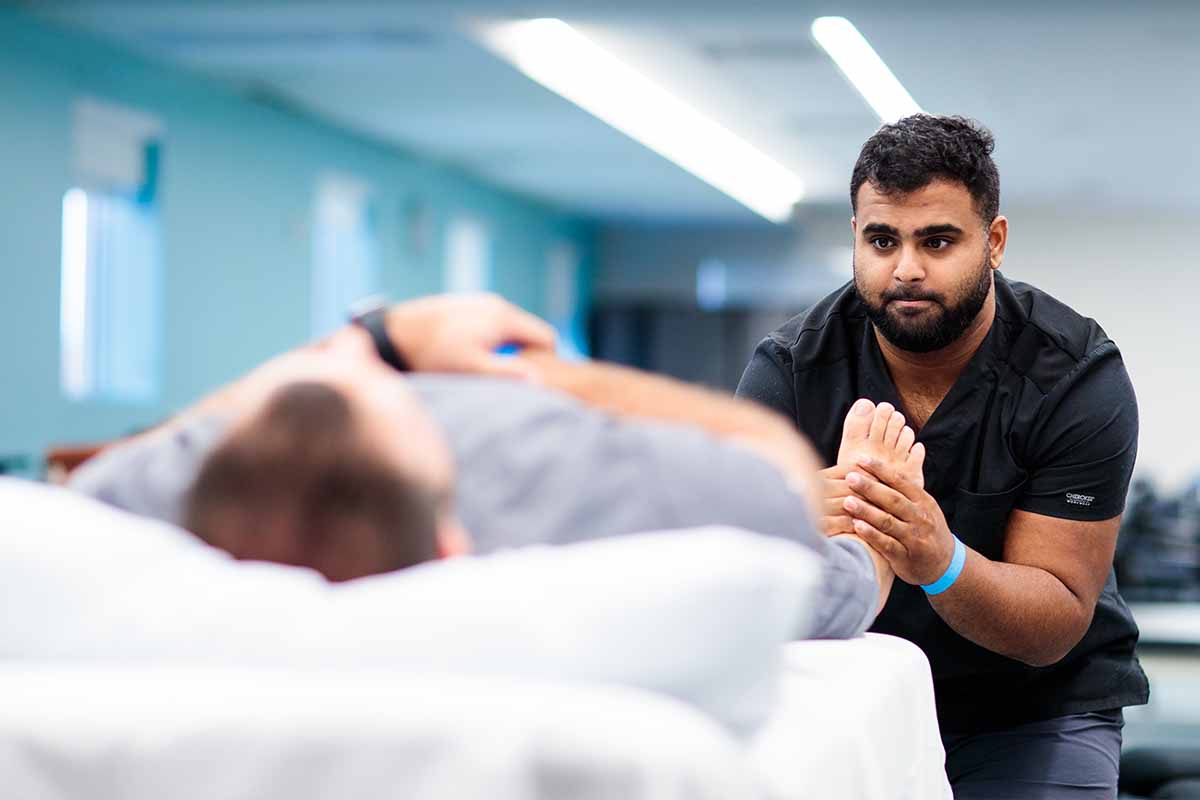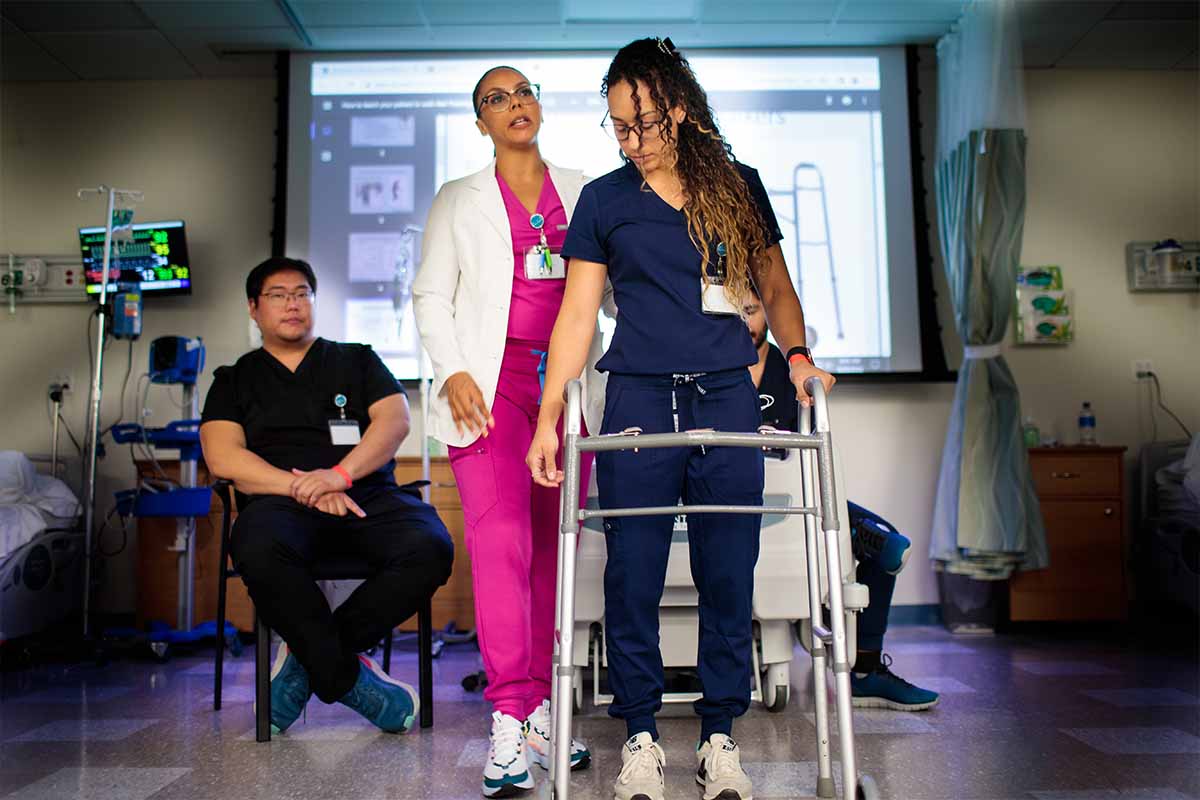
Ranked the seventh best healthcare career by U.S. News & World Report, physical therapy (PT) is rich in opportunity for people who want to help patients live better lives.1 Physical therapists treat injuries, disabilities and other health conditions through personalized treatment plans that include exercise and hands-on rehabilitation.2
How do you become a physical therapist? What are the steps to becoming a physical therapist?
A Doctor of Physical Therapy (DPT) is the entry-level degree for this position, so read on to discover the typical pathway for how to become a physical therapist.2
Table of Contents:
- Earn a Bachelor’s Degree in a Related Field
- What Degree Do You Need to Be a Physical Therapist?
- Pass the National Physical Therapy Exam (NPTE)
- Obtain a License to Practice
- Complete a Residency (Optional)
- Earn Board Certification (Optional)
- FAQ
- Launch Your Physical Therapy Career With USAHS
1. Earn a Bachelor’s Degree in a Related Field
Typically, the first step for how to become a physical therapist is to earn a bachelor’s degree, which most DPT programs require for application.2 Most DPT programs do not require a specific undergraduate degree as long as your coursework satisfies their admission requirements. At the University of St. Augustine for Health Sciences (USAHS), DPT admission course requirements include anatomy, chemistry and physics, which are common prerequisites for this program.3 Some of the best undergraduate degrees for physical therapy include biology, kinesiology and exercise science.
2. What Degree Do You Need to Be a Physical Therapist?
Next on the list of steps to become a physical therapist, you’ll likely need to complete a DPT degree, which can take about three years.2
What to Look for in a DPT Program
When looking at DPT programs to become a physical therapist, choose a program that fits your needs.
Ensure your DPT program is CAPTE-accredited.* You can only qualify for the required-for-licensure National Physical Therapy Exam (NPTE) with a degree from an accredited institution.4
Explore DPT program total cost and financial aid opportunities. Ensure you understand the program’s tuition and fees so you can budget accordingly and apply for relevant scholarships to help offset these costs. Check out USAHS’ tuition information and scholarships page.
Investigate how long the program is. The length of the program determines when you can become a physical therapist and enter the workforce. The typical DPT program lasts about three years, but you may be able to find accelerated programs that allow you to graduate earlier.2
Visit potential campuses. Ensure the campus is convenient and you feel comfortable there. USAHS offers five different campuses:
Focus on collaboration. At USAHS, our curriculum is designed to facilitate teamwork as you explore how to become a PT. We bring together occupational therapists (OTs), physical therapists (PTs) and speech-language pathologists (SLPs) to foster an integrated approach we term interprofessional education. Since so many physical therapists work as part of a larger healthcare team, this is an essential skill to learn.5
Consider program pathways. USAHS offers for how to become a physical therapist to ensure there’s a degree pathway that works for everyone:
- Residential DPT: This is the traditional pathway, which features blended courses that include in-person sessions with online components and weekday on-campus labs. Pursue this pathway at all five USAHS campuses.
- Flex DPT: This pathway for how to become a PT involves online coursework and in-person labs on select weekends. Currently, this pathway is an option at the San Marcos, CA; St. Augustine, FL and Austin, TX campuses.
- Hybrid Immersion*** DPT: This online and in-person pathway offers a flexible way to become a physical therapist while living almost anywhere in the U.S. It combines live, online coursework and, on average, two immersive, in-person labs per term. Currently, the hybrid immersion*** pathway is available at our San Marcos, CA and Miami, FL campuses.
- Student-centered philosophy
- Hands-on learning opportunities and simulation labs
- Access to cutting-edge technology
- Opportunities to engage professionally through conferences and research
Applying to DPT School


Once you’ve picked a DPT program, the next step in how to become a physical therapist is to apply. Getting into physical therapy school is pretty straightforward once you know your program’s admission requirements.
- If required, take the GRE.
- Apply to the DPT program using the Physical Therapist Centralized Application Services (PTCAS).6
- Submit any required documentation. At USAHS, we require:
- A current resume
- A statement of purpose
- Transcripts showing completion of prerequisite courses
- of 40 volunteer, observation or work hours in a physical therapy setting
- after acceptance into the program
DPT Curriculum
Once you’ve enrolled in the program, the DPT curriculum includes a range of coursework. At USAHS, our curriculum may include classes covering the following areas:
- Anatomy
- Patient care
- Physiology
- Biomechanics
- Musculoskeletal
- Neuroscience
- Clinical reasoning
Clinical education, which involves supervised experience in a clinical setting in different areas of physical therapy, should also be part of your curriculum.2


3. Pass the NPTE
Once you’ve received your NPTE scores, the next and typically final step in how to become a PT is to apply for state licensure.7 However, requirements may vary by state. For instance, some states require a law exam and a background check to complete the process.7 Contact your state board of physical therapy for more information about how to become a physical therapist in your state.13
Remember that if you wish to work as a travel physical therapist or virtual physical therapist, you’ll need a license to practice wherever your patients live.14
4. Obtain a License to Practice
Once you’ve received your NPTE scores, you’ll typically apply for your state’s license to practice.6 However, additional requirements may vary by state. For instance, some states require a law exam and a background check to complete the process.6 Contact your state board of physical therapy for more information about how to apply for a physical therapist license in your state.
Remember that if you wish to work as a travel physical therapist or virtual physical therapist, you’ll need a license to practice wherever your patients live.12
5. Complete a Residency or Fellowship (Optional)
Once you have your license, you can practice or choose to take a few extra steps in the process of how to become a PT to deepen your knowledge.2


You may pursue a clinical residency or fellowship after getting your license. These optional programs are designed to increase the quality of your patient care and deepen your knowledge of best practices.15 Research also shows that fellow-trained physical therapists may achieve greater treatment effect sizes than therapists without residency or fellowship training.16
A clinical residency is a post-professional learning experience centered on developing knowledge, skills and responsibilities of advanced physical therapy practice.15 These typically last one year and help prepare a physical therapist for board certification.7 The American Board of Physical Therapy Residency & Fellowship Education (ABPTRFE) currently offers residencies in the following areas15:
- Acute Care
- Cardiovascular & Pulmonary
- Clinical Electrophysiology
- Geriatrics
- Neurology
- Oncology
- Orthopaedics
- Pediatrics
- Sports
- Women’s Health
- Wound Management
A clinical fellowship is a post-professional learning experience, but the goal is to expand a physical therapist’s knowledge, skills and responsibilities in a specific subspecialty.15 The candidate will need to have already completed a residency or specialty certification, or they must have board certification in the specialty area.15
ABPTRFE currently offers fellowships in the following areas15:
- Critical Care
- Hand Therapy
- Neonatology
- Neurologic Movement Disorders
- Orthopaedic Manual Physical Therapy
- Performing Arts
- Spine
- Sports Division 1
- Upper Extremity Athlete
The application and admissions process for residencies and fellowships vary based on individual state requirements, so if you wish to follow these steps to become a physical therapist, consult each program’s admission guidelines.17,15
6. Earn Board Certification (Optional)
Another option in the process of becoming a physical therapist is getting board-certified through the American Board of Physical Therapy Specialties (ABPTS).18,2 Earning your board certification involves passing an exam and completing the required hours of clinical work within your chosen specialization.7
Employers prefer to hire board-certified physical therapists.19 Many physical therapists who become board-certified may see a salary increase or non-financial rewards such as promotions or increased authority and responsibility, although this depends on the setting.
Currently, ABPTS offers board certification in the following areas:20
- Cardiovascular & Pulmonary
- Clinical Electrophysiology
- Geriatrics
- Neurology
- Orthopaedics
- Oncology
- Pediatrics
- Sports
- Women’s Health
- Wound Management
Board certification applications are due no later than September 30.21 You’ll also need to complete specialty-specific requirements.22
FAQ
Now that you know how to become a physical therapist, learn more about what it entails to be a physical therapist. Read through the questions and answers below.
What Do Physical Therapists Do?
A physical therapist is a healthcare professional who prescribes a treatment plan to improve a patient’s mobility and manage any discomfort or pain associated with movement.23 They may ask patients to perform exercises or show them how to use adaptive equipment, such as a cane.5
They work as part of a healthcare team that may include other physical therapists, surgeons, doctors, physician assistants and specialists.
Where Do Physical Therapists Work?
Physical therapists typically work in the following settings:24
- Offices of physical, occupational and speech therapists and audiologists
- Hospitals
- Home healthcare
- Nursing or residential care facilities
Some physical therapists are self-employed or may offer virtual physical therapy
services, while others may work as travel physical therapists and work where needed.
Launch Your Physical Therapy Career with USAHS
USAHS has been a leader in physical therapy education since its founding in 1979 and is now the largest physical therapy school in the United States.**
Our student-first philosophy means you’ll experience an immersive education and graduate as a practice-ready professional. Hands-on simulation labs and state-of-the-art technology combined with our unrivaled faculty practitioners will prepare you to offer high-quality patient care now and in the future.
Learn more about our DPT degree program and apply today.
*The University of St. Augustine for Health Sciences is accredited by the WASC Senior College and University Commission (WSCUC), 1080 Marina Village Parkway, Suite 500, Alameda, CA 94501, (510) 748-9001, www.wscuc.org.
For programmatic accreditation, https://www.usa.edu/about/accreditation/.
**Based on total DPT degrees conferred during 2020-2022, as reported by the Integrated Postsecondary Education Data System (IPEDS). Data is captured by IPEDS through interrelated surveys conducted annually by the Department of Education’s National Center for Educational Statistics (NCES).
***The University of St. Augustine for Health Sciences (USAHS) is seeking approval from the Commission on Accreditation in Physical Therapy Education (CAPTE) for an expansion of its Doctor of Physical Therapy (DPT) program at its San Marcos, CA, and Miami, FL, campuses with a Hybrid Immersion model. Approval of the expansion programs is required prior to implementation.
Applicants interested in the Hybrid Immersion DPT format should contact an enrollment advisor using the request for information form on our site.
Salary data may not reflect starting pay for recent graduates.
Sources
- U.S. News & World Report, “Best Health Care Jobs,” U.S. News & World Report, 2024, https://money.usnews.com/careers/best-jobs/rankings/best-healthcare-jobs.
- American Physical Therapy Association, “Becoming a Physical Therapist,” APTA, 2024, https://www.apta.org/your-career/careers-in-physical-therapy/becoming-a-pt.
- American Physical Therapy Association, “DPT Admissions Process,” APTA, DPT 2024, https://www.apta.org/your-career/careers-in-physical-therapy/pt-admissions-process.
- Federation of State Boards of Physical Therapy, “Eligibility Requirements,” FSBPT, 2023, https://www.fsbpt.org/Secondary-Pages/Exam-Candidates/National-Exam-NPTE/Eligibility-Requirements.
- U.S. Bureau of Labor Statistics, “Physical Therapists: What Physical Therapists Do,” BLS, April 17, 2024, https://www.bls.gov/ooh/healthcare/physical-therapists.htm#tab-2.
- “Physical Therapist Centralized Application Service,” PTCAS, 2023, https://ptcas.cas.myliaison.com/applicant-ux/#/login.
- U.S. Bureau of Labor Statistics, “Physical Therapists: How To Become a Physical Therapist,” BLS, April 17, 2024, https://www.bls.gov/ooh/healthcare/physical-therapists.htm#tab-4.
- Federation of State Boards of Physical Therapy, “Future Key dates and deadlines,” FSBPT, 2023, https://www.fsbpt.org/Secondary-Pages/Exam-Candidates/National-Exam-NPTE/Dates-and-Deadlines/Future-Test-Dates.
- Federation of State Boards of Physical Therapy, “National Exam (NPTE®),” FSBPT, 2023, https://www.fsbpt.org/Secondary-Pages/Exam-Candidates/National-Exam-NPTE.
- Federation of State Boards of Physical Therapy, “Exam Registration and Payment,” FSBPT, 2023, https://www.fsbpt.org/Our-Services/Candidate-Services/Exam-Registration-Payment.
- Federation of State Boards of Physical Therapy, “Retake Exam,” FSBPT, 2023, https://www.fsbpt.org/Secondary-Pages/Exam-Candidates/National-Exam-NPTE/Retake-Exam.
- Federation of State Boards of Physical Therapy, “NPTE Exam Year Reports,” FSBPT, 2023 https://www.fsbpt.org/Free-Resources/NPTE-Pass-Rate-Reports/NPTE-Exam-Year-Reports.
- Federation of State Boards of Physical Therapy, “Licensing Authorities Contact Information,” FSBPT, 2023, https://www.fsbpt.org/Free-Resources/Licensing-Authorities-Contact-Information.
- American Physical Therapy Association, “About PT and PTA Licensure,” APTA, 2024, https://www.apta.org/your-practice/licensure/pt-and-pta-licensure
- American Board of Physical Therapy Residency & Fellowship Education, “For Physical Therapist Residency & Fellowship Participants or Prospective Participants,” ABPTRFE, 2024, https://abptrfe.apta.org/for-participants.
- Jason Rodeghero, Ying-Chih Wang, et al., “The Impact of Physical Therapy Residency or Fellowship Education on Clinical Outcomes for Patients With Musculoskeletal Conditions,” Journal of Orthopaedic & Sports Physical Therapy, January 31, 2015, https://www.jospt.org/doi/10.2519/jospt.2015.5255.
- American Board of Physical Therapy Residency & Fellowship Education, “Online Directory of Programs,” ABPTRFE, https://accreditation.abptrfe.org/#/directory.
- American Physical Therapy Association, “APTA Specialist Certification – Governed by ABPTS,” APTA, 2024, https://specialization.apta.org/?_ga=2.63550319.1175286054.1700158593-28393261.1699481062
- American Physical Therapy Association, “Employer View of Specialist Certification,” APTA, 2024, https://specialization.apta.org/for-specialists/marketing/employers.
- American Physical Therapy Association, “Become an ABPTS-Certified Specialist,” APTA, 2024, https://specialization.apta.org/become-a-specialist.
- American Physical Therapy Association, “From Application to Celebration: The Path to Your Specialist Credential,” APTA, 2024, https://specialization.apta.org/become-a-specialist/from-start-to-finish.
- American Physical Therapy Association, “Minimum Eligibility Requirements and General Information for All Physical Therapist Specialist Certification,” APTA, 2024, https://specialization.apta.org/become-a-specialist/minimum-requirements.
- Cleveland Clinic, “Physical Therapist,” Cleveland Clinic, March 7, 2024, https://my.clevelandclinic.org/health/articles/24625-physical-therapist.
- U.S. Bureau of Labor Statistics, “ Physical Therapists: Work Environment,” BLS, April 17, 2024, https://www.bls.gov/ooh/healthcare/physical-therapists.htm#tab-3.










